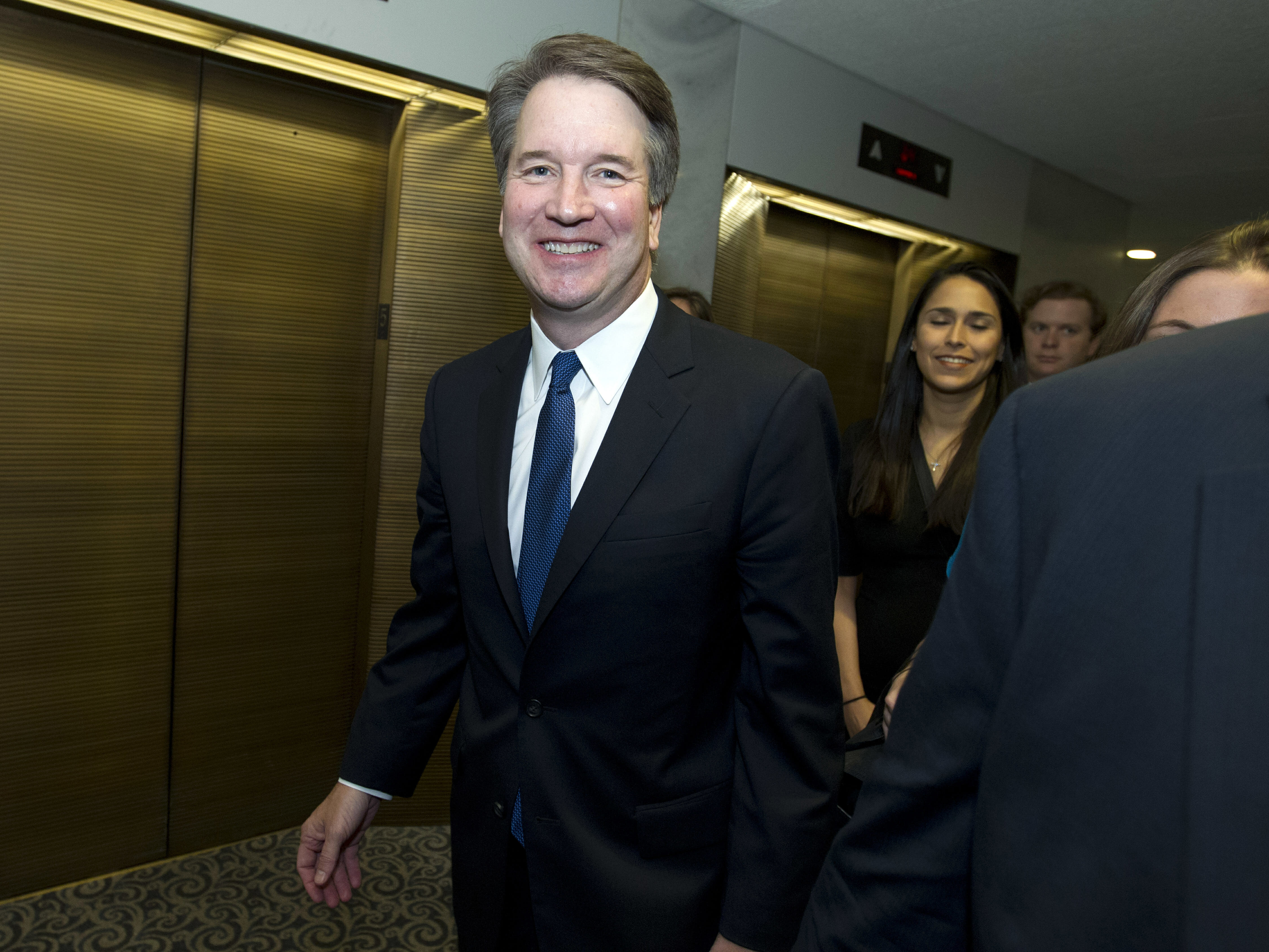Donald Trump Is Remaking the Supreme Court in His Own Image
And with Neil Gorsuch and now Brett Kavanaugh in tow, the president is well on his way achieving his objective. Brett Kavanaugh. (Jose Luis Magana / AP)
Brett Kavanaugh. (Jose Luis Magana / AP)
When President Donald Trump announced the nomination of Brett Kavanaugh to replace retiring Supreme Court Justice Anthony Kennedy at a televised ceremony in the East Room of the White House on July 9, both he and the nominee uttered a whopping pack of lies.
“In keeping with President Reagan’s legacy,” Trump said in perhaps his biggest prevarication, “I do not ask about a nominee’s personal opinions. What matters is not a judge’s political views, but whether they can set aside those views to do what the law and the Constitution require. I am pleased to say that I have found, without doubt, such a person.”
Lauding Kavanaugh as a “judge’s judge,” Trump made no mention of his personal disdain for the principle of judicial independence. Instead, he declared, with nary a trace of conscience or candor: “The Rule of Law is our nation’s proud heritage. It is the cornerstone of our freedom. It is what guarantees equal justice. And the Senate now has the chance to protect this glorious heritage by sending Judge Brett Kavanaugh to the United States Supreme Court.”
Taking the lectern to accept the nomination, a gushing Kavanaugh, his wife and two daughters looking on, thanked the president and proceeded to drop a massive whopper of his own:
Throughout this process, I’ve witnessed firsthand your appreciation for the vital role of the American judiciary. No President has ever consulted more widely, or talked with more people from more backgrounds, to seek input about a Supreme Court nomination.
Behind the scenes, the administration was telling the truth about why Kavanaugh had been chosen from a list of twenty-five potential high-court candidates that had been compiled with input from the Federalist Society and the Heritage Foundation.
In an email obtained by Politico that was sent to a select group of industry and trade-group representatives immediately after the nomination ceremony, the administration touted Kavanaugh’s pro-business record during his twelve-year tenure as an appellate judge, asserting that the nominee had voted to “overrule federal regulators seventy-five times on cases involving clean air, consumer protections, net neutrality and other issues.”
Singled out for particular praise was a 2016 opinion Kavanaugh had penned for a three-judge panel in which he argued that the Consumer Financial Protection Bureau was “unconstitutionally structured” and should be dismantled. Although Kavanaugh’s opinion was later overturned by a ruling of the full circuit court, the email commended Kavanaugh as a judge who “protects American businesses from illegal job-killing regulation.”
But in fact, the email may have actually understated Kavanaugh’s ultra-conservative record and how he might further the president’s policy agenda as a member of the high court.
During the run-up to Kavanaugh’s confirmation, a number of public-interest groups took a deep dive into his record.
One of the most thorough analyses was prepared by Public Citizen, the liberal-progressive non-profit founded by Ralph Nader. Appraising Kavanaugh’s opinions in split-decision cases (which best reveal a judge’s views), Public Citizen found:
In 18 of 22 cases involving consumer and regulatory issues or matters of administrative law, Kavanaugh sided with corporations against agencies, or with agencies against public-interest challengers.
In 11 of 13 environmental cases, Kavanaugh sided with corporations or states challenging the U.S. Environmental Protection Agency or other federal agencies for being too protective of the environment, or against environmental groups seeking stronger environmental enforcement.
In 15 of 17 cases involving worker rights, Kavanaugh sided with employers against employees or employees’ unions, or with employers against the National Labor Relations Board.
In seven of seven cases involving victims suing for compensation over police or human rights abuses, Kavanaugh sided with the alleged abuser and against the victims.
Other advocacy organizations, such as the Alliance for Justice, also published analyses, stressing Kavanaugh’s restrictive views on Obamacare, abortion rights, and immigration, and his expansive positions on gun rights and presidential powers.
In 2009, for example, Kavanaugh authored an article for the University of Minnesota Law Review in which he argued that sitting presidents should be immune from both civil suits and criminal prosecutions. Who better than Kavanaugh (along with Samuel Alito, Gorsuch, and Clarence Thomas) to protect Trump against special counsel Robert Mueller should issues involving the Russia investigation one day reach the Supreme Court?
Like Gorsuch, Alito, and Thomas, Kavanaugh is also a self-described “originalist” and “textualist.” He believes questions involving fundamental rights should be resolved according to the “original meaning” of the Constitution’s terms and provisions, as understood by the Founding Fathers and those who ratified the national charter. Such an outlook, critics charge, will place a host of liberal court precedents in jeopardy, ranging from abortion and affirmative action to same-sex marriage and civil rights.
All of this helps explain why Trump, rather than desert Kavanaugh after he was credibly accused by Dr. Christine Blasey Ford and Deborah Ramirez of egregious sexual misconduct in his younger days, stuck by his man, praising Kavanaugh’s unhinged September 27 testimony before the Senate Judiciary Committee. During his testimony, Kavanaugh seemed to channel the president’s own thoughts as he ranted:
This whole two-week effort has been a calculated and orchestrated political hit, fueled with apparent pent-up anger about President Trump and the 2016 election, fear that has been unfairly stoked about my judicial record, revenge on behalf of the Clintons, and millions of dollars in money from outside left-wing opposition groups.
The Senate’s subsequent vote to confirm Kavanaugh by the razor-thin margin of 50-48 wasn’t just a win for Trump in the near-term. It was a win for the far right well into the future.
The average retirement age for the last eleven justices who have served on the Supreme Court is eighty. The average tenure on the bench is twenty-seven years.
Kavanaugh is just fifty-three. Gorsuch is only fifty-one. Liberal Justices Ruth Bader Ginsburg and Stephen Breyer are eighty-five and eighty, respectively.
Even assuming Ginsburg and Breyer remain on the court for the duration of Trump’s presidency, this means, as White House press secretary Sarah Huckabee Sanders tweeted in a rare display of accuracy after Kavanaugh’s confirmation:
Instead of a 6-3 liberal Supreme Court under Hillary Clinton, we now have a 5-4 conservative Supreme Court under President @realDonaldTrump, cementing a tremendous legacy for the President and a better future for America.
As longtime GOP operative and Trump backer Roger Stone remarked in an interview with Politico in January 2017, after Trump had named Neil Gorsuch to replace the deceased Antonin Scalia: “If Trump is going to be a transformational president, not a transitional president, he needs a supportive court—a Trump court.”
With Gorsuch—and now Kavanaugh—in tow, Trump is well on his way to achieving that objective.
This article was originally published by The Progressive.
Your support matters…Independent journalism is under threat and overshadowed by heavily funded mainstream media.
You can help level the playing field. Become a member.
Your tax-deductible contribution keeps us digging beneath the headlines to give you thought-provoking, investigative reporting and analysis that unearths what's really happening- without compromise.
Give today to support our courageous, independent journalists.






You need to be a supporter to comment.
There are currently no responses to this article.
Be the first to respond.